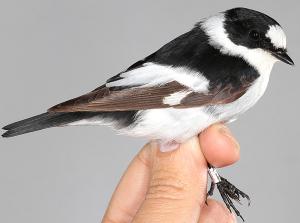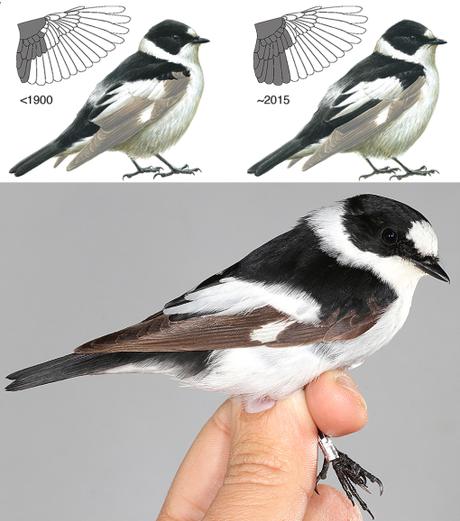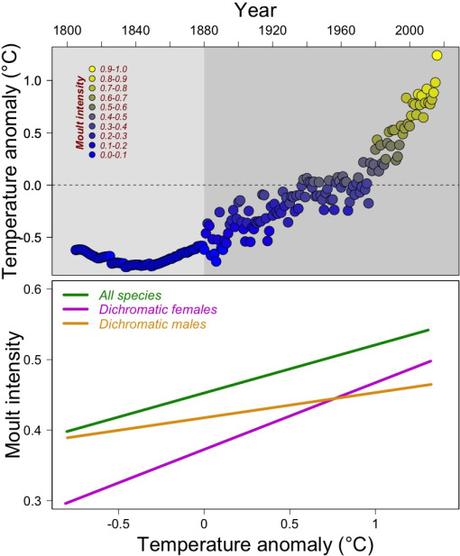Skilled ornithologists can tell the age of a bird by the look of its feathers. But many species are advancing the moult of their first adult plumage in response to global warming, and the youngsters look more similar to the adults now than two centuries ago.

The clothes don’t make the (wo)man, but how we dress sends out a lot of information about our tastes, emotional state, or financial situation. In nature, where species have evolved to exploit all kinds of physical and chemical cues, visual communication determines a wealth of feeding and reproductive strategies (1).
Birds are familiar to all of us by the beauty and variety of their plumages (see extreme examples commented by David Attenborough here, here and here), which bird fans use to tell juveniles from males, males from females and breeders from migrants. In evolutionary time, birds have gradually moved away from tree-bark browns and tree-leaf greens and, due to functional requirements, modern feathers only span about one third of the colours these animals can perceive (2). They obtain yellows, oranges, and reds from carotenoid-containing food, dark colours from melanin pigment of own synthesis, and the so-called structural colours depend on how light reflects on the barbs of the feathers (2).
Plumage, across its entire range of designs, is a factor crucial to the life history of our feathery friends and, consequently, to evaluate how and how much anthropogenic climate change is impacting them (3).
Plumage and temperature
We know that mammals and birds are modifying their fur and feathers to optimise camouflage against landscapes with more or less snow (4), but less-known are the implications of climate change for feather moulting.
The Israeli team led by Yosef Kiat has dealt with this phenomenon in 12 perching species (Passeriformes) from West Europe and North Africa, using the collections of ten European museums of natural history and the photographic archive hosted by the Internet Bird Collection (5). Kiat measured moulting intensity in 4012 one-year-old individuals spanning a historical record of 212 years (1805-2016) by counting the number of adult feathers present after the first moult in two body paths along wings and tails. It must be taken into account that young birds reach adult plumage through several moults over many years in large-bodied species (such as eagles or vultures), but in one single year in most (small) perching species.

Comparison of the number of adult feathers present after the first moult of two one-year-old males of the collared flycatcher (Ficedula albicollis) living in the 18th and 21st Centuries according to museum collections (5). The drawing illustrates that juvenile birds are moulting more adult feathers (grey shading) and resemble adults more now than two centuries ago. This is one case of a total of 19 study species comprising shrikes (Laniidae), thrushes (Turdidae), and wheatears and flycatchers (Muscicapidae). Credits: Paschalis Dougalis (drawing) and Yosef Kiat (photo). The specimen is a two year-old male ringed in 2019 by the Jerusalem Bird Observatory.
Kiat found that irrespective of the study species, the migratory distance and whether species moulted in breeding or wintering grounds, the number of adult feathers present in the plumage following the first moult has gradually increased at the pace of growing atmospheric warming. These authors also revealed that, in species with contrasting male and female plumages, females are outperforming males in moulting more of the first adult feathers.
Moulting demands a substantial energy investment from birds and is fueled by the availability of body and habitat resources (6), all the more so for large-bodied species (7). Therefore, birds seem to be adjusting how many feathers to moult into adult form in response to prevailing climate conditions. This opens up a panoply of potential climate effects on the biology of species.
Notwithstanding, the ongoing global increase in the mortality of the world’s avifauna (8) stands by itself as an adaptive pressure to fasten maturation and mate earlier in the face of a shorter lifespan, and might therefore conflate and/or interact with climate effects.

Shifts in moult intensity of the first moult over 48 wing and tail feathers from juveniles of 19 species of perching birds (Passeriformes) breeding in Western Europe and North Africa, relative to air temperatures over the last two centuries (5). Temperature anomaly is the difference between each annual average minus the average from 1951 to 1980 according to NASA records (dark gray = direct measurement, light gray = reconstruction based on glacier fluctuations). Moult intensity is the number of adult feathers post-first moult, averaged across all species and > 4000 individuals, and standardised to 0-1. The upper panel shows that moult intensity tracks air temperatures, and the lower panel supports that such relationship is stronger (larger slope) in females than in males for 10 dichromatic species (= sexes have different plumage coloration, although, strictly speaking, dichromacy implies two sets of eye color receptors).
Plumage and life cycle
Adult plumage is critical for survival because (i) adult feathers are higher in quality than juvenile feathers (9), and (ii) moulting (10) and care (11) of the former are particularly energy-demanding to individuals.
But if juveniles look more like adults during reproduction, surely they might be able to devote more time to mate in a life’s time, at least in species reliant on visual displays for mating (12). This can cash out demographic benefits if the frequency of reproductive events rises per individual or, in contrast, become disadvantageous if young birds get involved and lose more frequent interactions for resources with experienced adults (13).
It should come as no surprise that small-bodied and short-living bird species (those analysed by Kiat) are the ones that have evolved a subadult plumage that minimises competition with adults and looks little conspicuous to predators (14).
During the last three years through which we have been writing our series of articles on climate change and biodiversity, we have emphasised that the aggravation of anthropogenic climate change has occurred in only three generations from our children to grandparents, posing fast adaptive challenges to all species (see here, here and here).
Birds have unfolded multiple responses to cope with changing temperatures and precipitation (3), so migratory species are arriving and reproducing earlier in breeding grounds, and delaying or advancing their winter migrations whether they have to cruise short or long distances, respectively (15, 16, 17).
Some have even halted migration altogether because they currently have enough food and a friendly winter in breeding grounds, as we are witnessing in Spain with white storks (Ciconia ciconia). Now we know that the plumage for their migrations is also changing. Every species of bird is ecologically unique, and we can expect them to adapt in singular manners to climate change (18).
This realisation highlights the importance of future studies of life history of individual species — which are essential to the teaching and development of science, but gradually becoming less attractive for high-impact research journals and the (inter)national institutions that finance scientific projects (19).
—
Salvador Herrando-Pérez and David R. Vieites
With support of the Spanish Ministry of Science, Innovation and Universities
Note: This blog post is based on an article published in Spanish by the journal Quercus in December 2019.
References
- Osorio, D & Vorobyev, M (2008) A review of the evolution of animal color vision and visual communication signals. Vision Research 48: 2042-2051
- Stoddard, MC & Prum, RO (2011) How colorful are birds? Evolution of the avian plumage color gamut. Behavioral Ecology 22: 1042-1052
- Dunn, PO & Møller, A (2019) Effects of Climate Change on Birds (Oxford University Press, ed. 2)
- Zimova, M et al. (2018) Function and underlying mechanisms of seasonal color moulting in mammals and birds: what keeps them changing in a warming world?Biological Reviews 93: 1478-1498
- Kiat, Y et al. (2019) Feather moult and bird appearance are correlated with global warming over the last 200 years. Nature Communications 10: 2540
- Barta, Z et al. (2008) Optimal moult strategies in migratory birds. Philosophical Transactions of the Royal Society B 363: 211-229
- Rohwer, S et al. (2009) Allometry of the duration of flight feather molt in birds. PLoS Biology 7: e1000132
- Rosenberg, KV et al. (2019) Decline of the North American avifauna. Science 366: 120-124
- Jovani, R & Rohwer, S (2017) Fault bars in bird feathers: mechanisms, and ecological and evolutionary causes and consequences. Biological Reviews 92: 1113-1127
- Butler, LK et al. (2008) Quantifying structural variation in contour feathers to address functional variation and life history trade-offs. Journal of Avian Biology 39: 629-639
- Merilä, J & Hemborg, C (2000) Fitness and feather wear in the collared flycatcher Ficedula albicollis. Journal of Avian Biology 31: 504-510
- Levin, II et al. (2018) Experimental manipulation of a signal trait reveals complex phenotype-behaviour coordination. Scientific Reports 8: 15533
- Promislow, DEL et al. (1992) Mortality costs of sexual dimorphism in birds. Proceedings of the Royal Society B 250: 143-150
- Studd, MV & Robertson, RJ (1985) Life span, competition, and delayed plumage maturation in male passerines: the breeding threshold hypothesis. American Naturalist 126: 101-115
- Both, C et al. (2004) Large-scale geographical variation confirms that climate change causes birds to lay earlier. Proceedings of the Royal Society 271: 1657-1662
- Visser, ME et al. (2009) Climate change leads to decreasing bird migration distances. Global Change Biology 15: 1859-1865
- Jenni, L & Kéry, M (2003) Timing of autumn bird migration under climate change: advances in long–distance migrants, delays in short–distance migrants. Proceedings of the Royal Society B 270: 1467-1471
- LeBrun, JJ et al. (2016) Assessing the sensitivity of avian species abundance to land cover and climate. Ecosphere 7: 1-22
- Tewksbury, JJ et al. (2014) Natural history’s place in science and society. BioScience 64: 300-310

